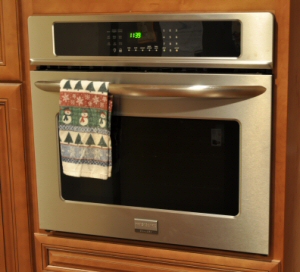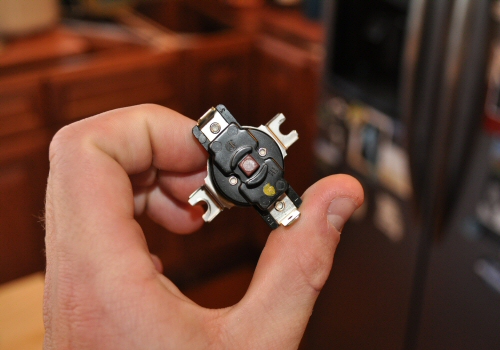
We recently installed a Frigidaire Gallery wall oven (model# FGEW3065KFA) from AJ Madison as part of our ongoing kitchen remodel (review of the oven itself is forthcoming). While branded Frigidaire, this model is actually manufactured by Electrolux, according to the manual.
We used the oven 3-4 times for baking, and then ran the self cleaning cycle to make sure everything was in order, and to clean up some of the mess from baking.
Immediately after running the self clean, the oven stopped working properly. Pre-heating the oven to 350 degrees took as long as two hours, and as soon as you opened the door, the temperature would drop 40-50 degrees and take another half hour to return to normal. This was a real bummer since it occurred just seven days before Christmas Eve when we were expecting the whole family for dinner!
We called Frigidaire’s warranty hotline and they directed us to three local repair shops. Of them, Metro Factory Service was the most helpful. Metro sent a guy out within 24 hours to take a look. He surmised the problem immediately: a blown thermal fuse in the back of the oven… or it could have been a relay in the control panel, but since he could hear the relays firing, the fuse was the most likely culprit.

He ordered a new part from Frigidaire/Electrolux and scheduled a follow-up for the morning of Christmas Eve (great service from Metro, by the way!!). It turns out that the part he ordered wasn’t actually a fuse, it was a breaker and could have been reset just by pushing the button on it. The manual wasn’t clear on that point (he said many of them aren’t). The breaker is located under the metal housing in the very back of the oven. The repair man decided to replace the switch with the new one in case the other was too sensitive.
Remember, always turn power off at the main breaker panel when working on an appliance. 220 volts can be lethal.
He replaced the switch, reset it, flipped on the main breaker, and a working oven was restored.
In case you’re wondering why the oven heated up slowly as opposed to not at all, the reason is that the thermal breaker sits on only one leg of the 220v line. When it blows, you still have 110 volts coming in from the other half of the circuit, but this isn’t enough power to heat the oven up to really high temperatures. The 110V line that remains also powers the front panel and the circulating fan, so the oven “appears” to be working fine, even though half of the heating capacity is shed. We were somewhat surprised that Electrolux didn’t include some type of error code on the panel when this happens.
Here’s a close up shot of the switch in the back of the oven. (Sorry, angles weren’t good for a great picture here).
And here’s a real close up of the switch itself.

Hopefully this helps someone out there on the ‘net one day soon. I searched all over for an answer to the problem and couldn’t find a clear, concise one anywhere. If you end up in this situation, you can indeed turn off the breaker, pull the oven out, and press the button to reset it. Just be careful (and, as always, follow our advice at your own risk!)







Voltage isn’t lethal, current (amperage) is.
No it doesnt matter mam your wrong, amps doesnt mean anything.
A stun gun carries 100,000 volts but no amps. If it contained even 1 amp, you would be dead.
Your confident assertion aside, amperage is what kills, Kyle. Anything above 0.2 A has the potential to be fatal.
This debate seems to crop up periodically. The reality is that the combination of voltage and amperage is really the danger… However, assuming no limit on the amperage of the source, the current your body will consume varies directly with the voltage. Hence, the voltage warning.
Remember Ohm’s law (V=IR)… The reason I wrote that 240 volts is lethal is based on the assumption that the amperage supplied is, for all intents and purposes, unlimited. As most oven / cook top breakers are at 50amps, this is more (much more, actually) than enough power to kill, and bridging 220 will kill you much faster with a bigger shock than bridging 110, although at 50 amps both could be lethal.
Wow, I wouldn’t have known what to do about that problem, either. Glad to hear it got fixed in time for holidays!
I am having same problem with my new FGEW3065KFA. The first time (after installation in March 2011) I ran the self clean it tripped the thermal protection switch on the rear of the oven. The oven would barely heat up and could not cook anything until I pulled the oven from the wall, reset the switch and everything was fine again. Yesterday I ran the self clean again and now the oven is barely heating up again. Is this a defective thermal switch or what else could be the problem. Will a new switch fix the “sensitivity” problem so the self clean can be used or is the switch really doing what it should and protecting me from the oven overheating due to some other problem?
LDPerry, Bad news on this one is that the problem is likely not a defective switch, but a defective design. In talking with the serviceman on the problem, he said that some cabinet boxes are less insulating than others. The cabinets that are pretty good insulators will tend to trap more heat, and the circulating fan inside the unit cannot keep the exterior cooled enough. Your solution is to ask Frigidaire for a refund and to buy another model.
Amp.. Volt… Monster… RedBull… whatever. Thanks for posting this article. I have the exact same model, and the exact thing happened to me. Glad to know that it is just the switch. I will try to reset it this evening. If that fails, then I will order the new part. Thank you so much for posting thisl
Cv
I had this problem and this reset button fixed my problem. Thanks for posting!!!
Electrolux top oven takes too long to heat up but bottom works fine, would this still be the reset button or another problem?
OMG! THANK YOU! We averted a major catastrophe because of your post! I was cleaning the oven in preparation for my daughter’s graduation party. Then it stopped working!!!! no time to call repairman– all this food to prepare!!!! I followed your instructions and the oven works now. Thank you! Thank you! Thank you!
Thank you so much.. This article helped a lot… in my case I live in a country where no frigidaire dealer… and I had my oven shipped to me oversea… your article was my best shot and I fixed my problem.
Thank you for your post. I could have gone through the schematic circuit by circuit and I would have found the thermal trip… It was nice not to have to spend more than the time to remove the back panel on this problem (on my Sunday morning)
Back to my coffee now thanks to you. Next time wife uses self clean I think I will pull stove out a bit and put small ‘helper’ fan ( like a small desk fan) to keep the back panel cooler.
Great post, man. Thank you!
thank you I have the same problem
Thank you! Thank you! We had the same issue. We ran the cleaning cycle for the first time and then did not use the convection oven until Christmas Day. The oven would not heat up. This morning, I reset the fuse and it is working just fine!
Great post! I had the same slow-heating problem, and the ‘one leg off’ 120V power makes sense. However, I lucked out with an even a quicker fix.
Surprisingly, it was fixed when I flipped off the 240V breaker in the main house panel. Beats me why. I did have it off for a couple of minutes before flipping it back on. So maybe something with the 240V breaker (one leg open), or maybe something with the oven’s electronics. Anyway, I am passing this along as something to try before pulling the oven from the wall. I think the problem might have originated after running the self-cleaning feature. Not sure about that, though.
Thank you for posting this. I recently bought a house with the oven and I have been having the same problem. Now I’m going to pull it out and give this a try. So thankful for this post!
Thank you for posting this. I recently bought a house with the same oven and I have been having the same problem. Now I’m going to pull it out and give this a try. So thankful for this post!
Thanks for the info on the oven it has just happened to me just after a cleaning and 15 or so days before Christmas. Thanks again for the help 👍
Thank you Fred! Your explanation of why it heats slowly but still heats is excellent. I now have hope it can be repaired by a competent technician (not me). Btw, does yours have VariBroil? It is a great feature, one that I have not seen on any other oven, the reason we hope to keep the thing for as long as possible.
Fred,
Here we are more than 9.5 years after your post, and it keeps on giving.
You have explained precisely what I have noticed. I told my wife I should be able to figure this out and replace the appropriate part. Now I will!
Through testing and timing, I knew it was partially heating from the bottom element and fine on the top. That didn’t make sense to me without it being the oven control board. Loved your explanation.
Regarding, the volt vs amp discussions, who cares which one was more impactful to my electrocution. I’m still dead. That’s the point of the warning.